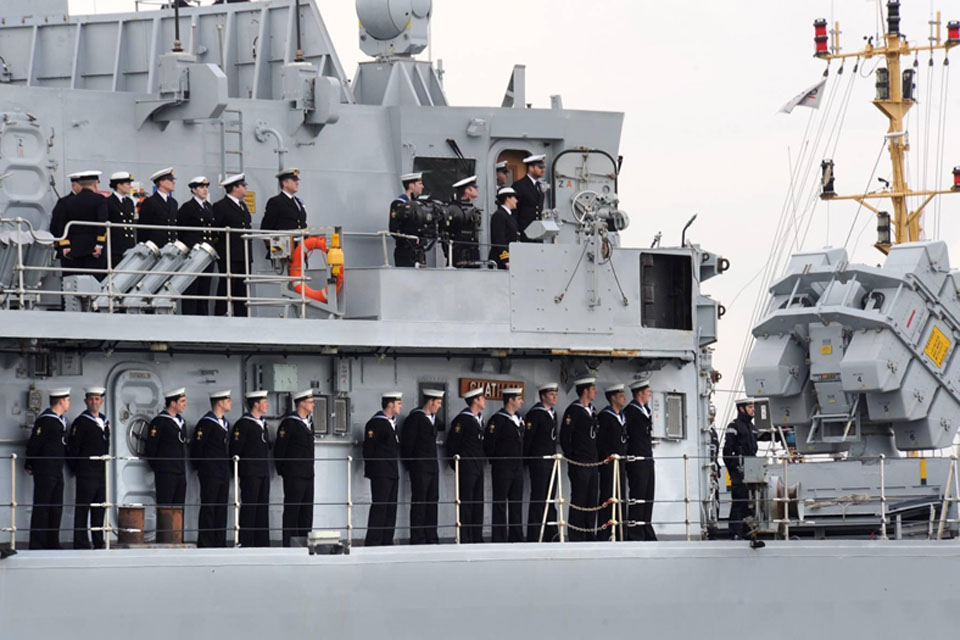HMS Chatham's final homecoming
Tears were shed at the final homecoming of the Royal Naval warship HMS Chatham yesterday as she entered HM Naval Base Devonport, Plymouth, for the last time after 20 years of service.

HMS Chatham enters HM Naval Base Devonport for the last time [Picture: Crown Copyright/MOD 2011]
Well-wishers waved the Type 22 frigate home as she sailed across Plymouth Sound and fired her ceremonial guns escorted by tugs firing water from their fire hoses high into the sky in salute.
The ship’s decks were lined with sailors standing proudly to attention, though a few had damp eyes.
HMS Chatham flew a special long white and red pennant to mark her final entry into Devonport before decommissioning.
Commander Simon Huntington thanked the people of Plymouth who lined the coastline and gave the ship a rousing welcome home:
It was good to see lots of people come to see us sail by for the final time into Devonport, it was much appreciated. This day was one of mixed emotions,” he said.
But we have been preparing for this day for a time now. It is a privilege to be here at the final moments of a ship’s life. For me especially I was proud to be the last Commanding Officer of HMS Chatham.
But also it was a day tinged with sadness to see a ship which has given 20 years of excellent service to the government and country come to Devonport for the last time.
The ship has a great legacy to be proud of and includes attending as guard ship to the royal yacht, the handover of sovereignty of Hong Kong in 1997, evacuations during the Sierra Leone civil war in 2000, and being at the right place at the right time in 2004 for the Asian tsunami and providing humanitarian support.’’

Members of HMS Chatham's crew lining her decks on the ship's final approach into Devonport Naval Base [Picture: Crown Copyright/MOD 2011]
The ship’s multi-role capability and flexibility have been the key to her success in humanitarian and operational tasks over the years. HMS Chatham also gave gun fire support during the Iraq War.
Commander Huntington said the ship’s final fate had yet to be determined and preparations would now be undertaken for the decommissioning process. But the priority was to ensure the least disruption to the crew as they leave the ship in the coming weeks.
He said some had already left for new jobs and training in other Royal Naval ships and establishments and exciting careers in the Royal Navy still remained for them.
The ship’s return marks the start of a number of key decommissioning activities including an official decommissioning ceremony in the naval base on Tuesday 8 February 2011.
Members of the crew will also say farewell to their affiliate town when they exercise their historic right to the Freedom of the Borough of Medway with a special last parade through the streets of Chatham in Kent on Saturday 12 February 2011.
HMS Chatham is one of the Royal Navy’s four Type 22 frigates, all Devonport-based, which are being decommissioned under the Government’s Strategic Defence and Security Review.
Commander Huntington added:
These ships are the longest serving frigates in the Royal Navy and given the requirement to reduce the number of surface units it is sensible to decommission our older assets.
HMS Chatham’s sister ships, HMS Cornwall, HMS Cumberland and HMS Campbeltown, will continue to support operations in the Middle East and in UK waters until later in the year. Nineteen escorts will then remain in service, including the highly capable Type 45 destroyers and Type 23 frigates.
HMS Chatham was laid down at Swan Hunters Shipbuilders Ltd in 1986, launched in 1988, and is the last of the four Type 22, Batch 3 frigates. Based in Plymouth, she is 150m long, has a crew of 250 and displaces 5,300 tonnes.
While officially designated a frigate, her comprehensive weapons fit gives her the fire power of a larger cruiser. She is capable of engaging targets above, on or below the sea. The ship carries anti-air and anti-missile Sea Wolf missiles, anti-ship Harpoon missiles, anti-submarine Sting Ray torpedoes and a Lynx helicopter; she is also fitted with a variety of guns, advanced radars, sonars, computer systems and communications equipment to carry out her tasking.
Powered by gas turbine engines, HMS Chatham can sprint at speeds of up to 30 knots. She is the seventh Royal Navy ship to bear the name; one of her predecessors had the honour of transporting the body of Admiral Lord Nelson from HMS Victory to Greenwich Hospital, where he lay in state until his funeral at St Paul’s Cathedral.